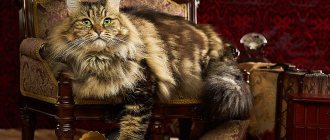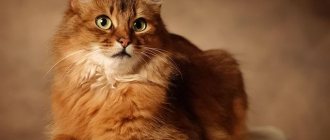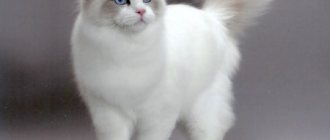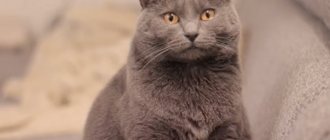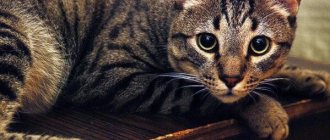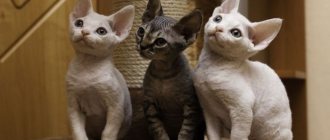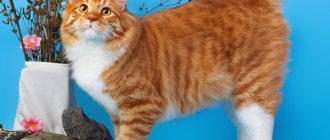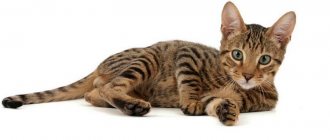The Chartreux is an elegant cat with a rich blue color. This is a temperamental animal with an independent character. Strong, muscular pets get along well with single people and in large families with children. The Chartreuse cat has gained popularity in Russia and Eastern Europe.
History of the Carthusian breed
The natural origins of the Chartreuse cat make it difficult to determine its ancestors. The most likely participation is from Egyptian cats or Pallas' cats, brought to Europe during the Crusades. Perhaps the kittens were brought from the Middle East or Africa by traders of exotic items. The first mentions of the Carthusian breed are associated with the city of Chartres in poems of the 16th century, as well as in paintings by French artists of the 18th century.
An interesting fact is that Chartreuse was originally bred to produce fresh meat or high-quality, dense, solid-colored fur.
During the First World War, France lost a large number of these cats, but the aristocratic appearance allowed the number of animals to be restored. There are few breeders left in Europe, but the breed has not been lost. In 1930, the Carthusian cat first appeared at the exhibition.
A new round of development is associated with the fact that the Chartreuse cat was the favorite pet of the legendary French statesman, Charles de Gaulle. The French began to breed the Carthusian breed more often, which spread throughout European countries, Canada, and the USA. The national Chartreuse standard was registered in 1977. 2 years later, the cats were recognized by the international community. However, in England the variety is still classified as British. While in Russia the breed cannot withstand competition with the domestic Russian Blue.
Description and standard
The Chartreuse has a solid constitution that belies the quiet voice.
Externally, the Carthusian Chartreuse cat has its own characteristics, which are quite strictly regulated by the standard of the World Cat Federation. Main features:
- Body type. The weight of males reaches 7 kg by the age of 5 years, while females gain no more than 5 kg. At this age, the average height of animals is up to 30 cm at the withers.
- Torso. The description of the breed defines the skeleton as primitive, with a natural origin. The compact, powerful frame of Carthusian cats is consistent with strong, large muscles. The animals' chest is quite wide.
- Limbs. The leg bones of the Carthusian cat are thin, shorter than average. The paws are round but strong.
- Head. The skull is wide rather than long, so the jaw protrudes slightly. The cats' forehead is high and quite flat, which in combination with full cheeks creates the feeling of a slightly flattened muzzle. The ears are set wide, leaning forward. The top edge is smoothly rounded.
- Eyes. The rounded shape is combined with a rich amber color. The iris tone is uniform, the look has a vibrant shine. At birth, kittens have grayish-blue eyes.
- Wool. The coat of Carthusian cats is thick, short, with a padded undercoat that is pleasant to the touch.
One of the main characteristics of the breed is its uniform, rich gray color. The typical Chartreuse also has gray paw pads, nose and skin under the coat. If there is a black or pink tint, the animal is rejected.
What is the difference between a Chartreux and a British cat?
Externally, the French Chartreuse has many similarities with the blue British Shorthair cat. Almost identical coat color and build make the breeds confuse, but not only experts can find differences between animals. It is enough to pay attention to the following signs:
- Wool. The difference in coat is not very noticeable, but upon closer inspection one can notice the shorter printed coat of the British. The main hair and undercoat of Carthusian cats differ in length, creating a two-layer effect.
- Head. The British cat has a more rounded head shape, a wide, heavy muzzle with large cheeks. While the chartreuse skull is similar to a trapezoid, and the jaw is narrower and longer.
- Ears. In Carthusian cats they are larger and wider apart, while in British cats they are small and more inclined forward.
- Tail. The tip of the chartreuse is clearly narrower than the base. The British Shorthair has a shorter tail with equal thickness throughout its length and a rounded tip.
Health
If the maintenance rules are followed correctly, Chartreuse will live a long life and will be in good health. However, prevention of standard diseases is still necessary. Vaccination for cats of this breed is standard.
The only point that you should pay attention to is the fragility of the musculoskeletal system.
Cats have fragile musculoskeletal systems
The bones of the animal, due to its large build, are constantly under pressure. In order to avoid their fracture, the cat should not be overweight.
Chartreux cat - description of the breed
The Chartreux is an independent French cat belonging to the Carthusian breed.
- It has a large and muscular body, while being very agile and flexible. The cats are somewhat larger than cats and have a calm temperament.
- The bones are strong, with well-developed muscles. The cats are medium in size. The hind legs are strong, with well-defined angles. The tail is of medium length, proportional to the body and rounded at the tip.
- Depending on the sex and age of the animal, the size, color, coat structure and eye color differ. The body weight of a male cat is 6-7 kg, that of a female cat is 4-5 kg. The final formation of the individual occurs by the age of three.
- The Chartreuse cat is suitable for people who love pets with aristocratic, intelligent manners that are good at communicating.
- You can recognize the animals by their unique graceful muzzle, distinguished by thick massive cheeks, a high forehead and a straight long nose.
- The coat is short and lies close to the body. Depending on the habitat, it may have an undercoat with varying degrees of density.
French Chartreux cat breed
This breed became known for its docile nature. Cats become strongly attached to the home and family in which they live. Although they try to be independent, they still love their owners madly. Their coat is very easy to care for, combing it two to three times a month with a furminator for short-haired animals. Particular attention should be paid to the pet during the molting period, which occurs twice a year: in spring and autumn.
French Chartreuse has good health. However, a purebred cat is also susceptible to some breed diseases. It is worth monitoring your body weight. The French tend to be overweight, which has a detrimental effect on joints and overall health. You should also pay attention to the condition of your teeth. Otherwise, cats are in good health. Before purchasing a kitten, you need to be prepared for the fact that the pet will be silent. This breed is distinguished by a rare expression of its voice. Only in extreme cases will the owner be able to hear a slight wheezing sound similar to a meow.
Blue chartreuse
The Chartreux cat breed is considered not playful, but jealous and demanding of attention. At the same time, a balanced character allows you to get along with different pets. However, remember - they are hunters at heart and you should not keep hamsters or birds close to them. They feel great both in the company of their owner and alone with a couple of favorite toys.
Buying a kitten
Choosing a kitten is a responsible step, because you are purchasing not just an animal, but a new family member who will become your faithful friend for the next two decades.
A Siberian pet will definitely become a member of your family, so you should take its choice seriously
Some tips:
- Prepare theoretically in advance: try to learn as much as possible about the characteristics of the Siberian breed and the rules for its maintenance.
- “Try on” the cat to your home conditions: think about where he will eat, sleep, go to the toilet, and play.
- Be sure to come to a consensus with all your family on the issue of purchasing a cat - the animal will feel comfortable if it does not bother anyone.
- In a timely manner, select everything necessary for the kitten: bowls for food and water, a tray, a scratching post, combs and toys, stock up on food.
And of course, the most important thing is to decide what kind of kitten, where and why you want to buy. As has already been said, there is nothing wrong with even bringing a cat into your home from the street, much less buying it at a bird market or borrowing it from friends. There are a lot of options - but none of them guarantee that a miracle will happen and thus a truly purebred animal will appear in your home. There is little chance that it will be at least healthy and with a stable nervous system.
A kitten from the street or from friends may differ from the breed standards, even if it looks very similar to a Siberian
How to choose
If you want guarantees, choose a reliable breeder first, and only then a kitten. The choice of nurseries that breed the Siberian breed today is quite large, and they all value their reputation. They will help you choose a child based on his expected prospects and your ambitions.
Do not buy a kitten that is too small - let him grow up a little next to his mother, who will teach the basic rules of cat behavior in the house
If possible, talk to the baby's parents - their appearance and behavior can outline the characteristics of the pet you choose. Listen to the breeder's recommendations - this will help you properly raise a healthy and beautiful animal.
Carthusian cat - character
An independent and calm disposition are the hallmarks of the breed. Be prepared that all the attention in the family will be turned to their four-legged friend, who will bring many emotions to life. Chartreux - a cat whose basic information is hidden in the breed standard, will try to become the only pet, due to innate jealousy and thirst for attention. At the same time, the animals are diligent and easily get along with children. They love to play and run around in the apartment. Chartreuse has an independent character, but at the same time compliant and flexible.
Chartreux - how to train?
The Carthusian Chartreuse pet is easy to train and will quickly master the rules of the family. However, the animal needs to be given attention to replenish its hunting instincts and curiosity. Playful, active felines will not refuse a short street walk and entertainment with toys. Raising it will be easier if you adopt your pet as a kitten. With older individuals it is a little more difficult, since you need to earn the authority and trust of the animal. To do this, you need to regularly contact your pet, responding to its requirements.
Highland Fold, Highland Straight
Highland Fold breed history: The very first Scottish Fold cat, Susie, was short-haired, but had the long-hair gene, which was passed on to some of her kittens. And since all Scots are descendants of Susie, purebred Scots often gave birth to long-haired kittens. However, exhibition systems recognized them only in the 80s. This is how the longhaired Scots or Highlands were legitimized.
Highland Fold character: Highlands are calm, reserved and affectionate.
Description of the Carthusian cat breed
The Carthusian cat was developed in France several centuries ago. Its purpose was to catch mice and rats in monasteries, and they were also used as a source of meat and fur. This attitude towards the breed persisted until the 19th century. During the First World War, Chartreux was practically exterminated; breeders had to put a lot of work into restoring the population.
The French cat differs from the British cat in having longer and darker hair. Plus, the Carthusians have a head that resembles an inverted trapezoid, while their brethren have a circle.
Chartreuse against the British
The Chartreuse breed standards have the following features:
- The head shape is an inverted trapezoid;
- The nose is wide and straight, gray in color;
- The ears are medium, rounded, high set and slightly tilted forward;
- Eye shape – round, large;
- The eyes are located close to each other, the color varies from yellow to copper;
- The physique is strong, with developed muscles;
- The hind legs are straight, massive, rounded;
- The color of the pads should match the color of the coat;
- The height of the pet is 30 cm, the weight of the cat is 6-7 kg, the cat is 5 kg.
Chartreuse color
The coat of the Carthusian cat is soft and thick so much that it is comparable to expensive types of fur-bearing animals. The coat has 2 levels: the top, characterized by silkiness and length, and the bottom, a dense and water-repellent undercoat.
The color of the Shertreuse coat can vary from light to darker.
The color of the coat can range from the lightest to the darkest gray. A light tone is a sign of distinction and a higher level of “thoroughbredness.”
Maintenance and care
There are no special requirements for keeping and caring for a pet. However, the following points should be taken into account:
- Cats are inactive, so wide spaces and multi-story structures are not required;
- There is no point in organizing a bed or shelter for a cat, since the pet will choose where and how it is comfortable for him to sleep. It will not be possible to change his decision;
- There is no need to restrict the animal’s movement around your home. In an attempt to get to the place it needs, the animal may get injured;
- Regular walks will improve your cat's well-being and mood. The opportunity to hunt and get some fresh air is essential for cats of this breed;
- The process of washing Chartreuse can be inconvenient . The wool is so thick that it does not get wet immediately, and the process of washing out the shampoo and drying the hairs will take a long time. Therefore, this breed is washed once every 6 months;
- Your pet should be brushed weekly. And when the molting process occurs - daily;
- The animal's eyes should be cleaned every day, and its ears once every 2 weeks;
- Chartreuse cats often suffer from tartar, so you should regularly brush your pet's teeth with a special toothpaste.
The animal loves to run and climb
There is no need to restrict his movements
Nutritional Features
Pets are not picky about food. They are fed twice a day, in small portions. The only features of the diet are the following:
- Once every 7 days the animal must eat fish;
- It is forbidden to eat fatty meat - pork, salted fish;
- Milk or fermented milk feed must be given daily.
Since Carthusian cats constantly lick their thick fur, their diet should contain supplements or food with the effect of removing hair from the stomach.
Animal temperament
The Carthusian cat has a calm disposition, low activity at home and high activity outdoors. The pet loves affection, but is not annoying; it prefers to lie in its favorite place for a long time, half asleep.
They treat water calmly. They can coexist with any other animals, as they are not aggressive. Children are loved and not harmed. Chartreux dogs are highly intelligent and quickly get used to the owner’s speech.
Due to their calm nature and patience, Chartreux are excellent ambushers and excellent mousecatchers.
Chartreux loves tranquility
TOP nicknames
The name choices for Chartreuse are endless. French origin can serve as a source of inspiration. Many owners emphasize the pet’s size and beautiful appearance with its name or draw parallels with outstanding historical figures, movie heroes and show business stars.
You can call a chartreuse “boy”:
- Hercules;
- Henri;
- Paul;
- Galileo;
- De Gaulle;
- Napoleon/Bonaparte;
- Renoir;
- Gray;
- Fabio;
- Maurice.
You can call a Chartreuse “girl”:
- Coco;
- Marseillaise;
- Josephine;
- Gloria;
- Antoinette;
- Mona;
- Gretta;
- Naomi;
- Zemfira;
- Cassandra.
Cat price
The Carthusian breed is rare both in Russia and in Europe. It is almost impossible to purchase a kitten on the territory of the Russian Federation. That's why they are ordered abroad. The cost of one small pet will be in the range of 40-100 thousand rubles.
Prices for kittens start from 40,000 rubles
When choosing a kitten, you should read its passport, which should contain information about parents, vaccinations, date of birth and health status.
At this time, the eye color will finally change, and the extra marks in the color will disappear.
On the territory of the Russian Federation there are only 2 nurseries where you can buy Chartreux dogs: CATBAY and Silver Silence. Both are located in Moscow.
Purchasing a Himalayan kitten
If you have studied the breed enough or your friends recommended it to you, then you can make a choice. Many people who decide to purchase a purebred kitten believe that any cat can be found in an advertisement, but this is not so. Himalayan cats are a relatively new breed, which means that such animals have not yet managed to become boring domestic cats. A Himalayan kitten cannot be picked up on the street. If you are very lucky, you can find a kitten from those whose Himalayan cat has already lambed. But even if the baby has Persian fluffiness and color-point coloring, this does not mean that he will pass this on to his children. After all, a cat’s blood may contain the genes of an outbred father. Therefore, if you need a purebred kitten, it is better to contact a nursery or private breeders.
My friends had a similar situation. The woman was looking for a purebred kitten, but purebred ones were too expensive, and the owners of the fluffy sofa babies did not want to give up. Then she just began to wait. Every week she bought newspapers with advertisements and went to the indicated addresses. At one of the addresses they gave her a purebred baby. He was 2-3 months old, but he already knew the tray and was vaccinated. The former owners asked only 50 rubles for him, saying they simply could not cope with a large litter. Years passed, and when a friend of mine once took her cat to the clinic, they told her that he was not purebred, but simply fluffy. Of course, she still didn’t leave him. He still lives with his kind and thrifty owner.
Due to the Persian appearance of Himalayan cats, you can easily make a mistake when choosing a kitten
Criterias of choice
When choosing a kitten, you need to pay attention to the following factors:
- reputation of the nursery (you can find customer reviews on the Internet);
- living conditions for animals (in a good nursery all animals are well-groomed, well-fed and happy);
- the appearance of the kitten you like (it should look healthy);
- documentation;
- baby's age.
At your request, the breeder (kennel owner) must provide documents for the kitten (passport and pedigree). The passport must indicate the vaccinations performed. Opposite the vaccination mark there should be a small hologram, the veterinarian’s signature and a seal. This is the only way to make sure that the kitten is truly vaccinated. The passport also indicates whether the kitten is spayed/neutered. In addition, the breeder can be asked to show the pedigree of the kitten and its parents. Even if both his parents are purebred, then their parents must also have a high-quality phenotype. If you adopt a kitten, the passport and pedigree must be given to you.
As far as I know from my experience, if the kitten is purebred, and the breeder likes you, he will offer all the documents himself. I found myself in such a situation when in a nursery I was approached not by the owner, but by a volunteer caring for the animals. I spent a long time trying to persuade this employee to show me the necessary documents, but he resisted. At some point I doubted, it even seemed to me that they wanted to deceive me. After some time, the owner of the nursery came and brought all the documents. So if you are refused, then call the owner or ask to explain the reason.
The age of a kitten at which it is better to adopt it
The smaller the Himalayan kitten, the more it looks like a “cloud”. But you cannot take the smallest kittens. Both veterinarians and breeders say one thing: furry pets can be adopted no younger than three months of age. And there are a number of good reasons for this:
- immunity;
- vaccination;
- social education;
- psychological reason.
Breastfeeding by the mother is very important for the health of the kittens. Only a nursing cat can give a baby primary immunity
This is especially important before the kitten reaches two months of age. In the third month, the cat is vaccinated. In addition, while the kitten is very small, the cat can teach it to play, communicate and go to the litter box. A Himalayan kitten must receive these skills from its nurse, otherwise it will never learn to care for its coat. If a kitten is separated from a cat too early, then in addition to health problems there will also be behavioral problems. And also when moving to a new house where the mother will no longer be there, the baby may experience extreme stress. Sooner or later this will certainly manifest itself in the character and habits of the animal.
You can’t adopt a kitten immediately after birth
